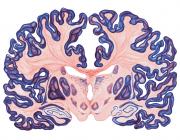The mediodorsal pulvinar coordinates the macaque fronto-parietal network during rhythmic spatial attention
Publication Year
2019
Type
Journal Article
Abstract
Spatial attention is discontinuous, sampling behaviorally relevant locations in theta-rhythmic cycles (3–6 Hz). Underlying this rhythmic sampling are intrinsic theta oscillations in frontal and parietal cortices that provide a clocking mechanism for two alternating attentional states that are associated with either engagement at the presently attended location (and enhanced perceptual sensitivity) or disengagement (and diminished perceptual sensitivity). It has remained unclear, however, how these theta-dependent states are coordinated across the large-scale network that directs spatial attention. The pulvinar is a candidate for such coordination, having been previously shown to regulate cortical activity. Here, we examined pulvino-cortical interactions during theta-rhythmic sampling by simultaneously recording from macaque frontal eye fields (FEF), lateral intraparietal area (LIP), and pulvinar. Neural activity propagated from pulvinar to cortex during periods of engagement, and from cortex to pulvinar during periods of disengagement. A rhythmic reweighting of pulvino-cortical interactions thus defines functional dissociations in the attention network.
Journal
Nature Communications

